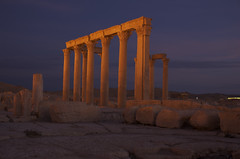When I sat down this evening to scribble some more nonsense, I skimmed over my output of the last half month and was mightily surprised at the strong presence of football. The topic features in every single one of the last five posts. I don't consider myself a football fan by any stretch of the word's meaning. I'm not fanatic about the sport, I don't watch league play and I don't care much about any team. But over the last twelve years I've developed an affection for my country that was totally foreign to me when I still lived there, and I've become ready to show my colors and support my country wherever I am out in the world.
My temporary single-mindedness must surely be tiring to follow, and I promise it will stop. The post in progress, coming at you with the unmitigated force of a Puyol header, will in fact be the last one on the subject. The reason is simple: The World Cup is over. Thick layers of tricolor face paint have been washed off, and my gigantic flag, a relic from darker times that is toxic to the touch and shows the scars of hastily excised circular coats of arms, lies neatly folded on the bottom shelf of my bedroom closet. The octopus was right; the dream is over. Germany is out.
It was a repetition of sorts of the team's effort of four years ago, when national enthusiasm carried the Mannschaft to an overall victory that was never in doubt while the players' bodies and legs were only good enough for a narrow loss in the semifinals. The reaction of the German press is repeating itself too. Only one day after the stunning collapse of the collective fantasy, the team is celebrated as the winner of the world's hearts.
Four years ago, that was probably true. Germany won more in that tournament than any other country and much more than it had expected when fighting to become the host nation. The face of Germany changed so dramatically in the three weeks of the World Cup that I hardly recognized my country when I visited for the quarter- and semifinals. Light-hearted happiness and open friendliness abounded where pessimism and gloomy suspicion traditionally reigned. All were family, foreigners were embraced, and everyone and everything were bedecked in black-red-and-yellow trim. After the narrow victory over Argentina, disorderly multitudes were dancing in the streets as if we were a tiny Caribbean nation that had just won its first international game ever.
Political pundits and frequent visitors alike didn't believe their eyes. Flags were everywhere, and people waved them proudly and with complete disregard of the associations to the past this normally evokes. The pennants became an expression of national joy that left the extreme left and the extreme right of the political spectrum unitedly aghast. The left had always cried wolf at any sign of national pride, lest the furies of war shall return. Now the right joined them by protesting what they considered the besoiling and belittling of the national colors. The reactionary negativism of these most unlikely bedfellows was so utterly out of touch with public spirit that it drove even more people to buy necklaces, temporary tattoos or bumper stickers in colors that had suddenly become fashionable.
After the group stage, the World Cup turned into some sort of Love Parade spill-over, a party that never slept. Pictures and video footage of the endless exuberance and cheerfulness that filled streets, parks and even stadiums where no games were played but giant screens erected were beamed into the world and changed the picture many had of Germans. More importantly, the German self-image was drastically and lastingly changed. The performance of the national team perfectly reflected that new mood with feel-good football.
Why should the national team's playing elicit the same response this time round? The change was made four years ago, and it has been sustained. Germans haven't retrenched into the caves of dolorous grumpiness. Flags are being waved most unthreateningly. The party is still on.
The major differences between the German 2006 and 2010 World Cup squads are age and origin. The team is young and liable to being thought of as representing the future, and it is multi-ethnic. Two of the core players were born in Poland; one has Turkish parents, another a Spanish mom and a third a Tunisian father. The most promising new striker, on the other hand, is called Müller – it doesn't get more German than that.
The attractive and successful style of playing of the German team has led a few commentators see in it the future of the country foretold. I've read suggestions of Germany as a model of integration, offering opportunities regardless of color or migratory background and developing pure talent.
I think such adulation is premature at best and maybe seriously misguided. The situation is much less rosy outside the elated realms of international ball-sport competitions. What does it really matter that an Anatolian hobbit is pulling the strings in midfield? Overall suspicion of the other is still great in Germany. Mosques are considered threats; citizen committees form to oppose and prevent their construction. CVs for most jobs require a passport photo, and a brown face doesn't increase an applicant's chances. Nor does a foreign-sounding name.
The situation might have improved over the last decade, simply because the forces of globalization are impossible to resist. Global mobility has changed the makeup of Germany, and conversations in English or Turkish are common in cafés and on the train. This has nothing to do with this year's World Cup, and the team doesn't reflect this. What it does reflect is the German Football Association's inclusive vision of success. I hope their model will be emulated by local authorities, enterprises and the wider society, even though the squad's progress to ultimate success was stopped by a mighty Spanish header.

No comments:
Post a Comment